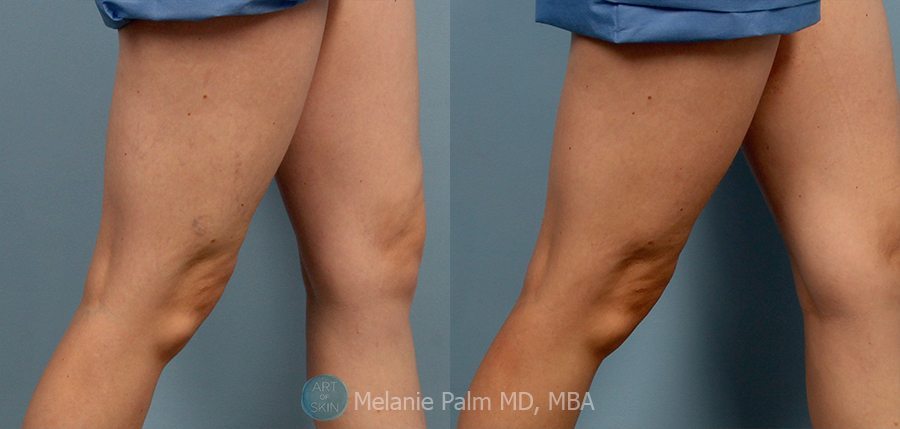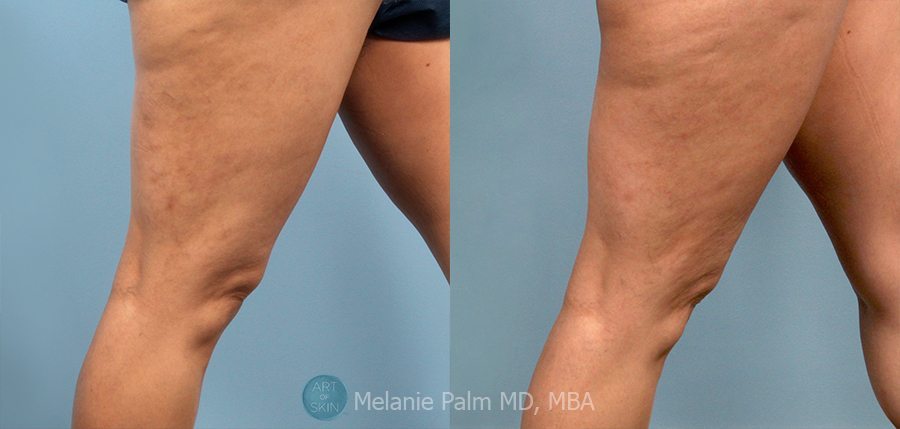Sclerotherapy
Dr. Palm's Expertise in Sclerotherapy
Dr. Palm is the first author of a published article in the medical literature on sclerotherapy, first author of an emedicine article on thrombophlebitis, as well as a co-author on an article for endovenous laser ablation. Below, Dr. Palm answers some of the most common questions about sclerotherapy.
What is sclerotherapy?
Sclerotherapy is the “gold standard” of treatment for most varicose veins and spider veins (telangiectasias) of the legs. The procedure itself involves the injection of various solutions with extremely small needles into the targeted veins. This process causes irritation of the vessel wall lining, leading to a reaction that seals the veins and leads ultimately to absorption and disappearance of the treated, abnormal leg veins.
What solutions are used during sclerotherapy?
Glycerin
Glycerin is a sugar solution that is used to treat veins of small diameter. It is injected into spider veins and provides very effective treatment of these small vessels. It has a very low incidence of side effects—hyperpigmentation (brown spots), ulceration, and telangiectatic matting are unlikely to occur with this sclerosing agent.
Sotradecol® (sodium tetradecylsulfate)
Sotradecol® is prepared as a solution for the injection of small, uncomplicated varicose veins. The solution is typically prepared as a foamed solution and injected into blue-green veins called reticular veins or varicose veins. Sotradecol® has been FDA-approved for use in sclerotherapy since 1998.
Asclera® (polidocanol)
Asclera® (polidocanol) is the newest product used for sclerotherapy. FDA-approved in 2010, Asclera® is used similary to Sotradecol®. It is approved for the treatment of spider veins and small varicose veins called reticular veins. Asclera® can be used as a foam solution to effectively treat reticular veins (small varicose veins). The active molecule of polidocanol creates an anesthetic effect upon injection, making sclerotherapy with Asclera® very comfortable for the patient. In clinical trials, polidocanol had superior effectiveness to other sclerosing agents. Asclera® also had a decreased incidence of side effects including post-treatment hyperpigmentation and ulceration.


Applied to Legs

Applied to Legs
What is sclerotherapy like?
Sclerotherapy is performed as a short, comfortable, in-office procedure. A typical treatment takes approximately 30 minutes to complete. The patient is placed in a reclined position during sclerotherapy and the treated area of the skin is cleansed with alcohol prior to treatment. The entire affected leg is treated from thigh to ankle. Glycerin is typically used to inject small spider veins. Sotradecol® or Asclera® is used in a foamed preparation to treat larger reticular veins (blue-green veins) and varicose veins. Very small needles are used to deliver sclerosing solution into the identified spider veins, telangiectasias, reticular veins, or varicose veins.
How many sclerotherapy sessions will I need?
Sclerotherapy should be performed as a series of treatments. The number of sessions is determined by the severity of venous disease and on individual responses to treatment. On average, patients require 3-6 sessions. A single session may improve the appearance of veins by approximately 40%. As sclerotherapy treatment does not remove the underlying tendency of patients with spider veins and varicose veins to develop new, abnormal veins, touch-up treatments may be required periodically.
How do I care for my legs after sclerotherapy treatment?
After sclerotherapy is complete, the nursing staff will apply graded compression stockings to the legs. Clinical studies have shown that wearing compression hose immediately following sclerotherapy treatment decreases the incidence of side effects and promote more effective clearance of spider veins and varicose veins. Compression stockings are worn for 7 days straight, 24 hours a day—even when sleeping or showering. Compression therapy during these times in particular is critical because veins dilate during showering or sleep, which can decrease the effectiveness of treatment if appropriate leg compression is not in place. Patients are encouraged to walk immediately following treatment, and every day thereafter to promote healing.
When do my veins improve and how long does sclerotherapy last?
The results from sclerotherapy take approximately 2 to 3 months to occur. Sclerotherapy should be performed as a series of treatments to accomplish complete clearance of spider veins, reticular veins, or varicose veins. Once a vein is treated, it will not recur. However, sclerotherapy does not cure but treats venous disease. The tendency to develop new spider veins continues, and touch up sessions may be necessary in the future.
What are the possible side effects associated with sclerotherapy?
Sclerotherapy is a well-tolerated procedure. However, like any medical intervention, there are side effects. Most side effects are minimal to mild in nature, and resolve over time. The most common side effects include itching, bruising, transient hyperpigmentation, new vessel formation, and temporary pain and swelling in the treatment area. If side effects are experience, the majority resolves within several days to weeks.
Is sclerotherapy treatment contraindicated for any individuals?
Yes. Patients with hypersensitivity or allergy to any of the sclerosing solutions, or their inactive ingredients should not be treated. Patients with a known, symptomatic heart condition called patent foramen ovale (PFO) have a relative contraindication to treatment with foam sclerotherapy (using sodium tetradecyl sulfate or polidocanol).
If you are looking for the best varicose vein and spider vein expert in the San Diego area to surgically repair your leg veins, call Dr. Melanie Palm at 858.792.SKIN (7546) to schedule your appointment.

